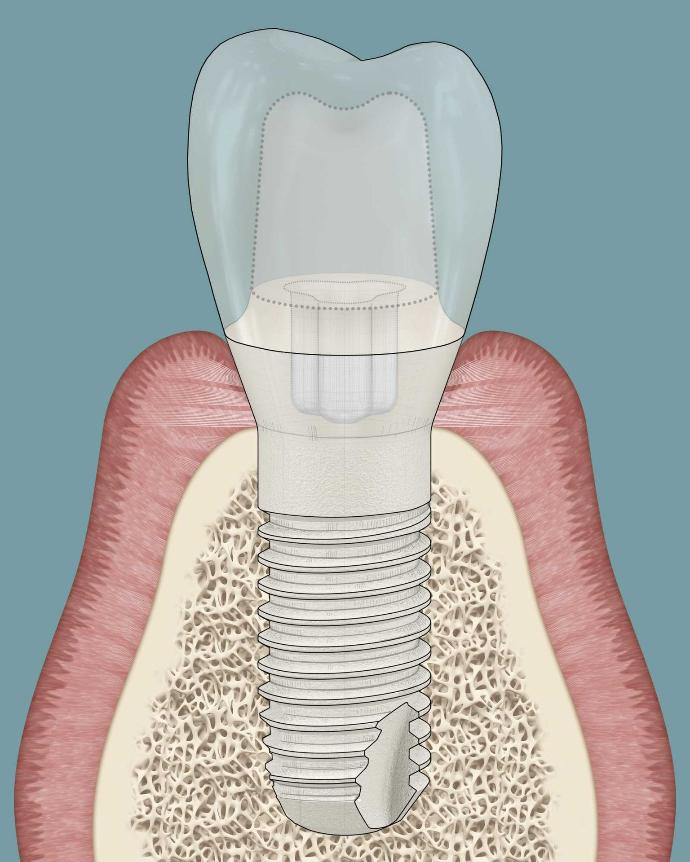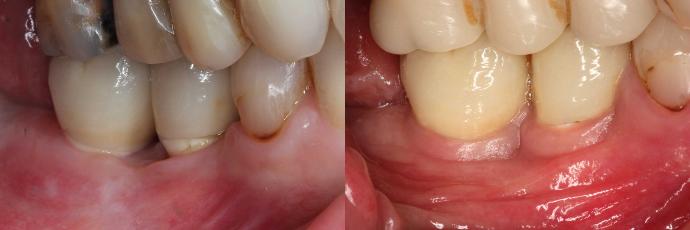- No peri-implantitis was found around two-piece Patent™ Dental Implants after up to 12 years[1]
- Even compromised patients showed only minor biological and no prosthetic complications
- Long-term data have confirmed the clinical performance of two-piece Patent™ Dental Implants[1, 2]

No peri-implantitis after up to 12 years—that is the most remarkable result of a new long-term study conducted at the Medical University of Graz and recently published in the International Journal of Oral and Maxillofacial Implants. The independent study has again confirmed the clinical performance of two-piece Patent™ Dental Implants (Fig. 1 on the left).[1]
The team, led by Dr. Sofia Karapataki, examined 39 patients with 91 implants after 5 and up to 12 years of function for biological complications. Biological complications like infections of the soft and hard tissue around implants are widespread: Peri-implant mucositis occurs in approximately 43%–47% of patients and 29% of implants, progressing toward peri-implantitis in an estimated 50% of cases.[3, 4] Once established, peri-implantitis is difficult to treat and in many cases ends in implant loss.[5] The findings of Dr. Karapataki et al. stand in stark contrast to this general prevalence of peri-implantitis. Moreover, they corroborate those of a long-term clinical study published in Clinical Oral Implants Research in late 2022 that also found no peri-implantitis around two-piece Patent™ Implants followed up for 9 years.[2]
Success rate of 100%
None of the 91 implants needed to be removed. No peri-implantitis occurred 5 to 12 years after implant placement, and there were only minor prosthetic and biological complications. Only three patients (7.7%; 9 implants) showed symptoms of peri-implant mucositis. Healthy soft tissue was observed in 36 patients (81 implants; Fig. 2 below). No marginal bone loss or only slight bone changes (< 0.7 mm) were observed in 85 implants. Six implants showed bone loss of more than 0.7 mm; the maximum marginal bone loss was 1.67 mm. The implant system therefore showed survival and success rates of 100%.[6, 7]

Two Patent™ Implants at baseline (left) and clinically stable tissue levels – with an increase in soft-tissue volume – at the 7-year control examination (right; © Karapataki et al.[1])
Transferability to daily practice
The results offer great transferability to everyday implant practice. Surgeries were done using classic standard protocols. All surgical and prosthetic treatment procedures as well as follow-up examinations were carried out in two private practices (Athens and Vienna). The surgeries were done using classic standard protocols. Apart from a minimum age of 18 years, there were no exclusion criteria. As a result, patients with general health conditions and diseases (e.g., Down’s syndrome or cancer) and under appropriate treatment (e.g., antihypertensives, antidepressants or immunosuppressants), with periodontitis and with a thin gingival biotype, and smokers were also included in the study. The indications were also not restricted in any way: Implants were placed in the maxilla and mandible as well as in the anterior and posterior regions, and simultaneous augmentation was performed if required.
Implants were placed between 2009 and 2016, and the last follow-up examination took place in May 2021. Initially, 47 patients were treated with 108 implants. Of these, 39 with a total of 91 implants were still available for a final examination. Marginal bone loss, pocket depth, bleeding on probing at four sites (mesial, distal, buccal, lingual) and oral hygiene (Simplified Oral Hygiene Index)[8] were recorded on the implant placement date and at the last follow-up examination.
Dr. Karapataki concluded: “The study documents outstanding long-term results achieved with the implant system investigated—including ‘real-life’ patients whom I treat in my practice on a daily basis. This offers hope for more implant treatments without peri-implantitis in daily practice.”

References
1. Karapataki S, Vegh D, Payer M, Fahrenholz H, Antonoglou GN. Clinical performance of two-piece zirconia dental implants after 5 and up to 12 years. Int J Oral Maxillofac Implants. 2023 Dec 12;38(6):1105–114. doi: 10.11607/jomi.10284. PMID: 38085741.
2. Brunello G, Rauch N, Becker K, Hakimi AR, Schwarz F, Becker J. Two-piece zirconia implants in the posterior mandible and maxilla: a cohort study with a follow-up period of 9 years. Clin Oral Implants Res. 2022 Dec;33(12):1233–44. doi: 10.1111/clr.14005. PMID: 36184914.
3. Derks J, Tomasi C. Peri-implant health and disease. A systematic review of current epidemiology. J Clin Periodontol. 2015 Apr;42 Suppl 16:S158–71. doi: 10.1111/jcpe.12334. PMID: 25495683.
4. Lee CT, Huang YW, Zhu L, Weltman R. Prevalences of peri-implantitis and peri-implant mucositis: systematic review and meta-analysis. J Dent. 2017 Jul;62:1–12. doi: 10.1016/j.jdent.2017.04.011. PMID: 28478213.
5. Abdelhay N, Prasad S, Gibson MP. Failure rates associated with guided versus non-guided dental implant placement: a systematic review and meta-analysis. BDJ Open. 2021 Aug 18;7(1):31. doi: 10.1038/s41405-021-00086-1. PMID: 34408127; PMCID: PMC8373900.
6. Buser D, Weber HP, Lang NP. Tissue integration of non-submerged implants. 1-year results of a prospective study with 100 ITI hollow-cylinder and hollow-screw implants. Clin Oral Implants Res. 1990 Dec;1(1):33–40. doi: 10.1034/j.1600-0501.1990.010105.x. PMID: 2099210.
7. Kohal RJ, Knauf M, Larsson B, Sahlin H, Butz F. One-piece zirconia oral implants: one-year results from a prospective cohort study. 1. Single tooth replacement. J Clin Periodontol. 2012 Jun;39(6):590–7. doi: 10.1111/j.1600-051X.2012.01876.x. PMID: 22519944.
8. Greene JC, Vermillion JR. The simplified oral hygiene index. J Am Dent Assoc. 1964 Jan;68:7–13. doi: 10.14219/jada.archive.1964.0034. PMID: 14076341.





